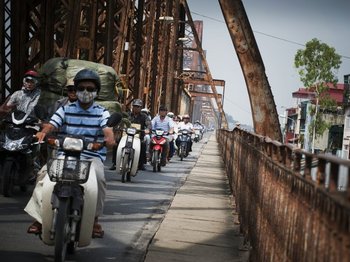More than half of the world’s internally displaced people (IDPs) live outside of camps – many of these people have found refuge in existing urban communities alongside the urban poor, refugees and migrants. The majority of these are women and children, who often stay in makeshift shelters, are exposed to violence, and struggle to access basic services, education and employment, notably due to their lack of personal documentation.
More information about IDP numbers and needs in urban areas is not only necessary for the provision of effective response in an emergency, but is also essential for targeted support for durable solutions.
The average length of internal displacement is a staggering 17 years, and finding solutions to protracted displacement has become a major challenge for governments, and humanitarian and development actors alike, as a new comprehensive study by the Brookings Institution highlights.
Data collection on urban displacement was a featured discussion at this year's Global Humanitarian Policy Forum, hosted by the UN Office for the Coordination of Humanitarian Affairs in New York on December 4, 2014.
Humanitarian policymakers discussed the need for more data to better understand the way pre-existing vulnerabilities intersect with displacement.
There is a particular need to focus on urban contexts where such vulnerabilities are harder to determine because IDPs find refuge among other disadvantaged populations and may also be wary of registering as IDPs for safety reasons.
Among the questions raised were: How to identify those in need? What methods can account for IDPs who may not wish to identify themselves for security or other reasons? Who are the best partners to identify the most vulnerable IDPs?
A number of guidelines emerged from the discussions:
Understand the reasons for collecting information.
Better data enables more targeted assistance, but collecting information also raises the community's expectations, which need to be managed. Political factors should also be considered. A government may want to showcase the presence of IDPs to attract international aid or on the contrary to minimise IDP issues to signal that displacement has been solved and that the country no longer faces a crisis. Ensuring the confidentiality of sensitive data, particularly on protection risks and violations, is also imperative, and is a challenge in urban areas where a multitude of actors, national and international, public and private, operate.
Determine the type of information needed
Data customarily cover IDPs’ location, needs and numbers, but data about their resources, resilience capacity, and options for solutions would also be highly valuable to policymakers. In addition to quantitative data, information to better capture the dynamics of displacement and the impact over time on communities would be helpful. Also needed is information about host neighbourhoods or cities, including their capacity to absorb IDPs, to better understand the relationships between IDPs, host communities, and authorities. Indeed, these relationships are complex, change over time and need to be periodically reassessed.
Assess methodologies
The Joint IDP Profiling Service (JIPS) has developed profiling methodologies particularly suitable for urban settings, which gather comparative information to assess vulnerabilities. The Internal Displacement Monitoring Centre (IDMC)’s model on urban violence in Central America has forecast the impact of the influx of IDPs on infrastructure, social services, and social fabric in both host areas and areas of origin.
An interesting aspect of this model is how it addresses IDPs and gang violence, highlighting the fact that some IDPs end up joining gangs rather than confronting them.
Work with a wide range of actors to get information in a complex environment
To get as complete a picture as possible, there should be outreach to non-humanitarian actors in urban contexts, such as police, hospitals, and local authorities who can provide important data on urban displacement. Humanitarian and development actors should cooperate, and several such initiatives in protracted situations were highlighted in the workshop. JIPS is working with the Special Rapporteur on the Human Rights of IDPs and other partners to define indicators based on the eight criteria for a durable solution, as per the Inter-Agency Standing Committee (IASC) Framework on Durable Solutions for IDPs. The Solutions Alliance Initiative has fostered collaboration between humanitarian and development actors to develop a common set of data. Close collaboration between humanitarian and development actors in protracted displacement settings is not without challenges, but they should be overcome and implemented more often.
Participants at the Forum agreed that more attention needs to be paid to urban displacement, a complex and growing problem, which requires better data to develop better policy responses.
Some questions for further discussion:
- Have community-based programmes in urban areas benefited from disaggregated data on both IDPs and host communities, including their specific vulnerabilities, needs and coping strategies?
- What are the experiences in providing support to local authorities on technical matters such as data collection?
- Are there experiences in using technology which led to a more equitable and systematized approach to assistance and protection of affected people in urban areas?
